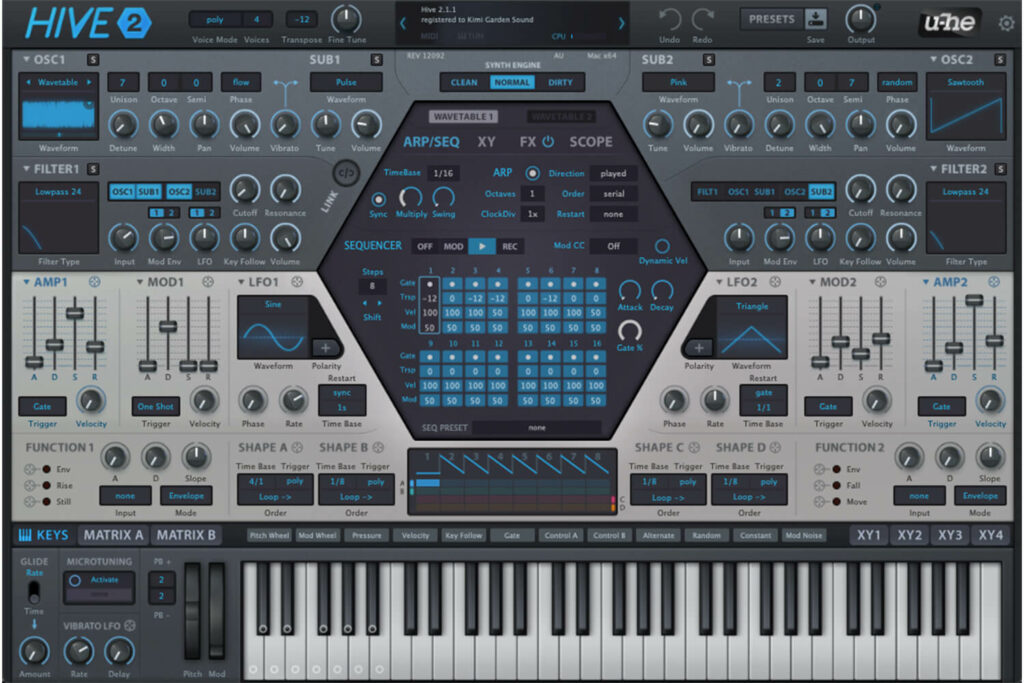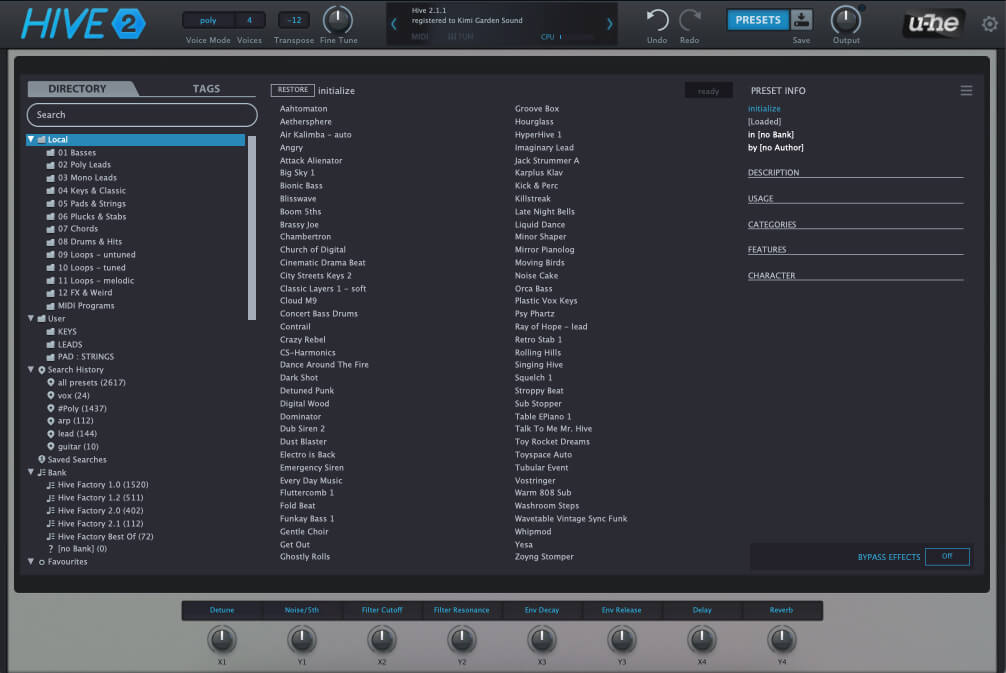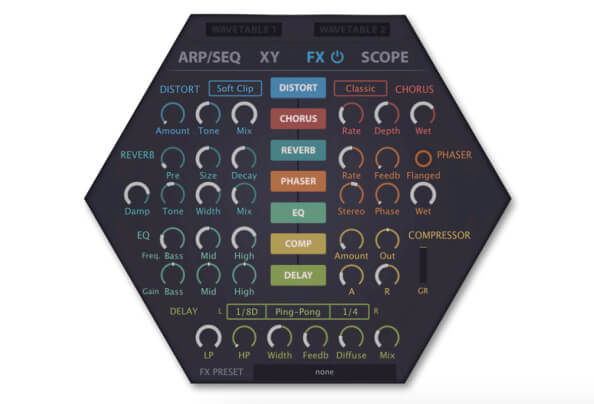User Interface and Workflow
The first thing that strikes you about Hive 2 is its clean and intuitive interface. The layout is designed for fast sound creation. Hive 2’s workspace is divided into three main panels: Oscillators, Filters, and Modulation Matrix, each clearly labeled and easy to navigate.

However, simplicity doesn’t mean limitations. Hive 2’s interface hides an impressive depth of control. The synth offers drag-and-drop modulation, easy assignment of parameters, and even a visual modulation matrix that provides a clear overview of what’s happening under the hood. The hexagon-themed design also provides a bit of visual flair that distinguishes it from other soft synths.
A scope view and preset browser are tucked at the top, allowing users to visualize changes or search for their desired sounds quickly. Whether you’re creating sounds from scratch or browsing through the 2000+ factory presets, the workflow is fast and efficient.

Sound Engine and Oscillators
At its core, Hive 2 features two oscillator sections, each capable of running in three modes: Normal, Dirty, and Clean. This gives producers access to everything from pristine, analog-like tones to grittier, distorted waveforms. The oscillators can generate standard waveforms (sine, saw, pulse, etc.), but the addition of wavetable scanning makes it incredibly versatile. You can load wavetables and morph between shapes, allowing dynamic, evolving sounds beyond traditional subtractive synthesis.

Read this next: U-he Repro plugin review
Hive 2 includes a sub-oscillator, noise generator, and ring modulator, offering a diverse sound palette. These features make it ideal for various genres, from EDM to cinematic scoring. The range of sounds—lush pads, sharp basslines, and unique sound effects—is truly impressive.

Modulation and Effects
Modulation is where Hive 2 truly shines. The modulation matrix is highly visual, making it easy to route various sources like LFOs, envelopes, and even MIDI control to any parameter in the synth. Hive 2 offers four LFOs, each with its own waveform options and tempo sync capabilities. This gives users precise control over modulation effects. You can drag and drop modulation sources directly to the target, making complex sound design tasks feel intuitive and quick.

Hive 2 also features four envelopes, including a global envelope for additional modulation tasks. Whether you’re using the envelopes for pitch sweeps, filter modulation, or amplitude shaping, their snappy response adds a professional sheen to your sound design.

The built-in effects section is extensive and includes reverb, delay, chorus, distortion, and more. Each effect is modeled with care, offering studio-grade processing directly within the synth. The EQ and compressor help sculpt and refine sounds, while the more creative effects like phaser and flanger can drastically alter the tone and texture of a patch. With these onboard effects, it’s easy to finalize sounds without needing external plugins.
| 5 Best Plugins for All EDM Producers

Wavetables and Shape Sequencer
Hive 2’s integration of wavetable scanning adds an entirely new dimension to the synth. You can morph between waveforms to create evolving, complex textures that breathe life into pads, leads, and basses. The wavetables can also be animated using the Shape Sequencer, a unique feature that lets users create rhythmic modulation patterns. This is particularly useful for creating evolving textures or rhythmic effects that sync perfectly with the tempo of your DAW.
Read this next: U-he Diva plugin review

The Shape Sequencer is divided into four lanes, each of which can control different parameters like pitch, filter cutoff, or wavetable position. It’s an incredibly flexible tool that can turn simple sounds into intricate, evolving sequences with just a few adjustments. Whether you’re looking for subtle modulations or complex rhythmic effects, the Shape Sequencer is a standout feature in Hive 2.

Performance and CPU Efficiency
One of the most impressive aspects of Hive 2 is its low CPU usage. Despite the wealth of features, effects, and modulation options, the plugin is surprisingly light on system resources. This makes it a go-to choice for producers working on complex projects or those with limited hardware capabilities. Even when using multiple instances of Hive 2, the CPU strain remains minimal, allowing for smoother workflow and higher track counts in your DAW.
Presets and Sound Library
Hive 2 comes with an expansive library of over 2000 factory presets, covering a wide array of styles and genres. From rich, evolving pads to gritty basslines and quirky FX sounds, the preset library is designed to showcase the depth of what Hive 2 can do. The sounds are crafted by industry-leading sound designers, ensuring that the presets are polished, usable, and production-ready. The preset browser allows for fast searching and categorization, so you can easily find the type of sound you’re looking for.
| Top 5 Melodic Techno Sample Packs

u-he also supports third-party sound banks. And because of Hive 2’s growing popularity, there are plenty of expansions available from various sound designers.
Potential Drawbacks
Although Hive 2 is a powerful and versatile synth, it might not be instantly accessible for beginners completely new to synthesis. Its deep modulation capabilities and wavetable synthesis might require a bit of a learning curve for some users. That said, its visual feedback and clear interface do help flatten the learning curve significantly. Then, most producers will find it easy to navigate after spending a bit of time with it.
Final Thoughts
Hive 2 is a versatile synth that combines ease of use with powerful control options. It’s perfect for producers seeking a CPU-efficient synth capable of delivering everything from punchy bass to rich soundscapes. The intuitive modulation system, wavetables, and Shape Sequencer make it a joy to use for complex sound design tasks, while the streamlined interface keeps everything manageable and fast.
Buy u-he Hive 2 below




